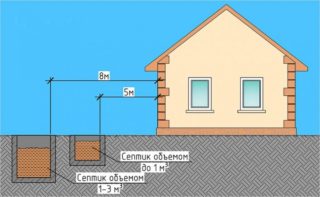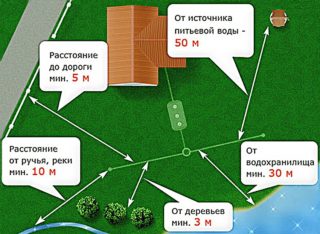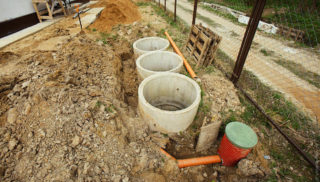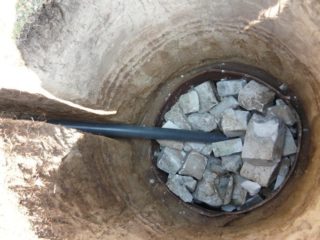Probably every second city dweller dreams of going out of town for the weekend, to nature, to clean and fresh air. Today, many settlements and villages are not equipped with a central sewerage system, in connection with which the question arises of purchasing a septic tank or arranging a cesspool.
SNiP and SanPin during the construction of a cesspool
The main document that you need to pay attention to in the first place is SanPiN 42-128-4690-8 and SNiP 30-02-97.
Choosing a place on the site
It is also worth noting that any containers with sewage pose a threat to nature and people, therefore there are undeniable rules for the location of this element on the site, namely:
- The main condition is the distance from the well or well to the cesspool, it should not be less than 25 meters;
- According to the norms of SES, a residential building can be located at least 12-15 meters from a tank with sewage;
- Also, do not install the pit closer than 2 meters before the neighbors' fence and 3 meters before the highway;
- Since over time around the drainage pit the soil moisture will be much higher, then additional buildings (gazebo, bathhouse, playground) will also be expedient to be carried 4-5 meters away from it;
- The ecological purity of the grown products will allow maintaining a distance of 10-13 meters.
Do not forget that certain fines are provided for violations of legislative norms, the amount of which depends on the severity of the violation. For example, a building with a filtering bottom can be located on a site only if the volume of wastewater is more than 1 cubic meter per day.
In addition to fines in court, you may be required to relocate or completely remove a building that is in dispute. What are the basic standards for the location of the drain pit on the site, their observance will protect you from various problems, including with the law.
What materials and when will suit us
There are two types of drainage pit:
- Bottomless or filtration. An example of this design is a standard country toilet. The main advantages of this structure are the budget price, ease of construction and ease of maintenance. However, as in any object, the village toilet also has its drawbacks, namely: not comfort, a long time for waste disposal, an unpleasant smell and the possibility of disrupting the ecological balance;
- With a bottom made of hard material.Such drain tanks have a sealed design, which allows them to be used for a larger amount of sewage, collection of household and utility waste. Construction is carried out using components such as reinforced concrete rings, brickwork, wood, unnecessary tires or plastic.
Today, in many specialized stores, it is possible to purchase a special ready-made container with a valve and reinforced walls for arranging a simple pit for draining sewage.
When choosing a material for a container, it must be remembered that long-term contact with the natural environment after a while will begin to destroy the walls of the structure, therefore the most optimal option would be to choose a component that is resistant to aggressive effects.
Procedure for obtaining permits
The final and most important stage, which brings you closer to the construction of a drainage pit, is to obtain all the necessary permits. They are issued by the local SES. Its cost is not high, about 200 rubles. The fine for the construction of this structure without permits is at least 500 rubles.
To receive the coveted piece of paper, the above service must provide a plan-diagram of the land plot on which the installation of the structure is planned. Only those projects that fully comply with all rules and norms of SNiP are subject to approval.
But this is not all the pitfalls, soon after the approval of the paper project, an inspector can visit your property, who will check and fix the correct location of the container on the site.
The best option, in order to avoid frequent mistakes, would be planning additional objects at the stage of creating a project and putting them on paper. This will allow you to approve the final plan and site and buildings on it and identify errors. After all, it is better to fix it on paper than to transfer existing buildings.
Installation features
A proportional amount of sand and gravel is poured onto the bottom of the excavated pit, thus creating natural filtration. Then a plastic container is placed on the created pillow and the foundation pit is poured.
In the case of installing a sealed septic tank, the bottom is poured with concrete, as in the construction of a foundation. The simplest and most common cesspool is a structure of concrete rings, erected on top of each other. The seams between them are covered with a special compound.
In rare cases, now you can find a drainage pit from a tree, but if you nevertheless decide on such a structure, you must additionally obtain permission from local state structures, and the wood itself must be pre-impregnated with a special compound that prolongs its service life. Such structures have a short service life and require major repairs in 3-5 years.
Correct operation or what is important to know
Subject to all the rules, there should be no special problems in operation. The main concern of the future owner will be the timely cleaning of the cesspool from accumulated wastewater.
Over time, there may be a problem of siltation, an increase in unpleasant odor and contamination of the walls of the structure, which significantly reduces its dimensions and as a result of which it is necessary to call the sewers more often and spend extra money.You can solve this problem by acquiring special bacteria, they are poured (or poured) into the container according to the instructions and they clean the tank on their own, and you can enjoy nature without limiting yourself in comfort.












